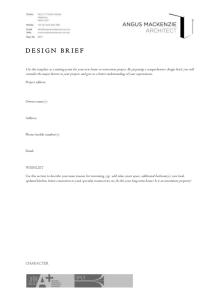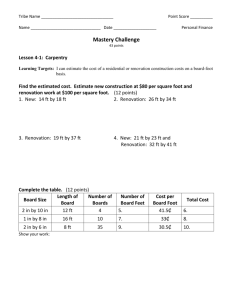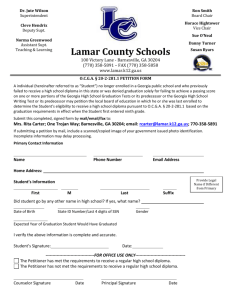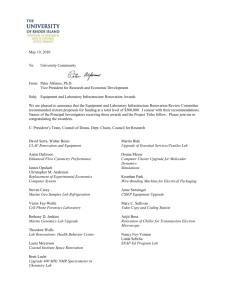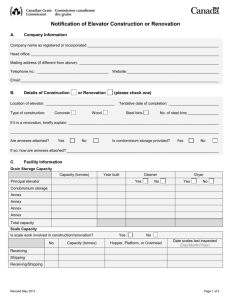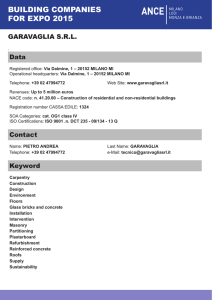Section 2 and Executive Summary - Flint River Regional Library
advertisement
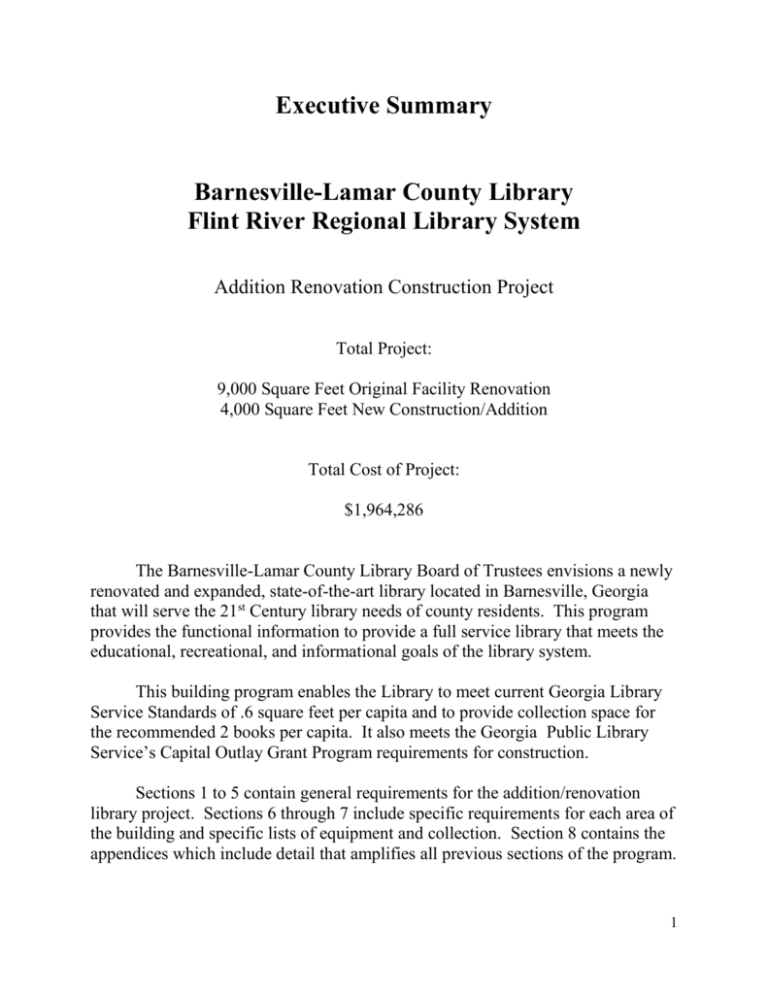
Executive Summary Barnesville-Lamar County Library Flint River Regional Library System Addition Renovation Construction Project Total Project: 9,000 Square Feet Original Facility Renovation 4,000 Square Feet New Construction/Addition Total Cost of Project: $1,964,286 The Barnesville-Lamar County Library Board of Trustees envisions a newly renovated and expanded, state-of-the-art library located in Barnesville, Georgia that will serve the 21st Century library needs of county residents. This program provides the functional information to provide a full service library that meets the educational, recreational, and informational goals of the library system. This building program enables the Library to meet current Georgia Library Service Standards of .6 square feet per capita and to provide collection space for the recommended 2 books per capita. It also meets the Georgia Public Library Service’s Capital Outlay Grant Program requirements for construction. Sections 1 to 5 contain general requirements for the addition/renovation library project. Sections 6 through 7 include specific requirements for each area of the building and specific lists of equipment and collection. Section 8 contains the appendices which include detail that amplifies all previous sections of the program. 1 II. INTRODUCTION This Building Program for the Barnesville-Lamar County Library is for a 4,000 square foot addition and renovation of the 9,000 square foot Library located at 401 Thomaston Street in Barnesville, Lamar County, Georgia. The purpose of a building program is to provide design professionals with the information necessary to develop the design of the addition and renovation for the Library. It contains the detailed needs as determined by meetings with Director Carrie Zeiger, Branch Manager Kelly Hughes, Lamar County Library staff, Board members and community representatives. The functional relationships of the Library will be described by a series of bubble diagrams; these functional relationships must be incorporated into the design of the Library: form must follow function. With any addition and renovation project, there are some unique challenges and the Barnesville Library offers several. Handicapped accessibility is a prime concern with space needed on the interior to meet these needs in restrooms and drinking fountains as well as turnaround space in the stack areas. Parking lot access for disabled people is also an issue and they must walk quite a distance from designated parking and up an incline. A new renovation and addition must provide reasonable accommodation for the disabled user under the requirements of the Americans with Disabilities Act. The children’s area is too small for adequate functionality, the circulation area should be modernized, the genealogy and local history area needs expansion, and the staff work areas are entirely too crowded. There is no space for staff to spread out materials or to take a lunch break. Storage, always a premium, is severely limited. Complicating the situation are the multi-purpose room and parking lot not serving the present and any future needs of the community. 2 This program will stress the goal of an environmentally friendly, economically feasible, easily maintained solution. The addition and renovation project will require creative space design to create a functional library operation. As a part of this renovation and addition, the Board would like to implement energy features particularly for heat and lighting. Each component should also be evaluated for future modernization. While at this time, self-service at circulation was not desired, it is far more economical to add conduit and power during renovation for these future enhancements. The consultants met with the board, Lamar County Library staff and the public on December 12, 2013 to discuss the goals for the construction project. A survey was also conducted during the same meeting. A. Project Summary In December 2013, planning began for a new library addition and renovation project located in Barnesville for the Barnesville-Lamar County Library, a member of the Flint River Regional Library System. The consultants were asked to: Develop a Building Program for a 4,000 square foot addition to the Barnesville Library and renovation of the 9,000 square feet of existing space. This program will provide guidance to the architect, engineers, and interior designer for the design of the new facility. Produce a cost estimate for the construction project including all site development, furnishings and equipment and technology needs. Produce a listing of needed furnishings and equipment required for the project as well as an estimated cost of these purchases 3 Assist the Lamar County Library Board as needed during this pre-construction period. In addition to working on the building program, the consultant team has reviewed planning documents regarding the library system’s services, operations, and other materials to assess the needs for this branch project. B. Project Need Lamar County is slowly gaining population according to the Barnesville Lamar County Chamber of Commerce. From 1990 to 2008, the county’s population grew by 21%, but has slowed during the economic downturn. Estimates by the Governor’s Office of Planning and Budget indicate that county growth will go from 19,596 in 2014 to 25,123 by 2030. Other demographic information is included below. Using the Georgia Office of Public Library Service Standards, a minimum of .6 square feet of public library space should be provided for residents of the county. These standards do not take into account the increasing need for more space brought about by technology. Serving Lamar County, Barnesville, and the surrounding area would require approximately 11,000 square feet. As of the census[6] of 2000, there were 15,912 people, 5,712 households, and 4,284 families residing in the county. The population density was 86 people per square mile (33/km²). There were 6,145 housing units at an average density of 33 per square mile (13/km²). The racial makeup of the county was 67.78% White, 30.39% Black or African American, 0.28% Native American, 0.37% Asian, 0.01% Pacific Islander, 0.28% from other races, and 0.89% from two or more races. 1.08% of the population were Hispanic or Latino of any race. 4 There were 5,712 households out of which 32.20% had children under the age of 18 living with them, 54.00% were married couples living together, 16.30% had a female householder with no husband present, and 25.00% were non-families. 21.60% of all households were made up of individuals and 8.90% had someone living alone who was 65 years of age or older. The average household size was 2.64 and the average family size was 3.05. In the county the population was spread out with 24.50% under the age of 18, 11.40% from 18 to 24, 27.90% from 25 to 44, 23.60% from 45 to 64, and 12.60% who were 65 years of age or older. The median age was 36 years. For every 100 females there were 91.90 males. For every 100 females age 18 and over, there were 88.90 males. The median income for a household in the county was $37,087, and the median income for a family was $43,481. Males had a median income of $29,453 versus $21,933 for females. The per capita income for the county was $16,666. About 8.10% of families and 11.20% of the population were below the poverty line, including 14.50% of those under age 18 and 11.00% of those age 65 or over.4000 square feet to meet the defined needs. A survey was conducted in December 2013 and January 2014 and the preferences are included in the Appendix. Uniformly, respondents noted the friendly and helpful staff. Most respondents reported using the library for materials and to participate in programming. They praised the children’s programming, but would like the library to be open on a more familyfriendly schedule. People noted the need for more computers and classes, meeting spaces for both large and small group use, and more access to historical records. A garden space was mentioned frequently as were specific types of special collections such as Christian fiction, books by African American authors, large print books and music. Most people completing the 5 survey were satisfied with services although many routinely used only one service such as the meeting space or to select books. C. Project Schedule. The anticipated project schedule for the Barnesville-Lamar County Public Library: Building Program Approval by Board State Grant Approved by Legislature, Signed by Governor Architect Selection & Architect hired Site Studies Schematic Design Begun Design Development Completed Working Drawings Approved Bid preparation Advertise for Bids Open Bids, Award Contract Construction Begins Substantial Completion Installation of Furnishings, Equipment Final Completion Open to the Public August 2014 May 2014 October 2014 November 2014 November 2014 January 2015 April 2015 May 2015 June 2015 July 2015 August 2015 May-June 2016 June 2016 July 2016 August 2016 This schedule may be expedited upon availability of funds and local preference, particularly in regard to how the existing building is used during construction, (a) if an alternative location has been considered for use during renovation activities, and (b) if the facility will have phased construction to enable staff and the public to maintain services in the facility. In general, approximately 9-12 months should be anticipated for construction. This building program statement will be the basic document to guide the architect in the requirements of each area of the building. Any change should be thoroughly discussed with Carrie Zeiger, Flint River Regional Library System Director and Kelly Hughes, Branch Manager, and in consultation when necessary with the Barnesville-Lamar County Library Board of Trustees prior to implementation. 6
